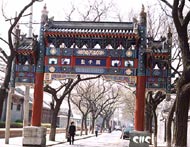|
|
The Imperial College (Guozijian)
|
|
| |
 The Imperial College is located immediately to the west of the Confucian Temple and, in fact, connects with the temple through a side gate. Generally recognized as the highest official institution of learning in imperial China, it was first established in 1287 during the Yuan Dynasty and subsequently enlarged several times, attaining its present dimensions during the reign of Emperor Qianlong of the Qing Dynasty. After the founding of the People's Republic in 1949, the Imperial College was completely renovated and the Capital Library was incorporated within its grounds.
The Imperial College is located immediately to the west of the Confucian Temple and, in fact, connects with the temple through a side gate. Generally recognized as the highest official institution of learning in imperial China, it was first established in 1287 during the Yuan Dynasty and subsequently enlarged several times, attaining its present dimensions during the reign of Emperor Qianlong of the Qing Dynasty. After the founding of the People's Republic in 1949, the Imperial College was completely renovated and the Capital Library was incorporated within its grounds.
After entering the main gate, the visitor will be confronted by a pair of wells and the Taixue (Highest Scholarship) Gate, also known as the Jixian (Assembled Virtue) Gate. Inside this gate is a glazed tile memorial archway with bell and drum towers to the east and west. Directly in front of the gate is the famous Biyong (Jade Disc) Hall. The square pavilion, which stands in the center of a circular pond, has a double-eaved roof surmounted by a gilded sphere. The pond is crossed by four marble bridges and provided on four sides with stone spouts in the shape of dragonheads. It was here that eh emperor came occasionally to expound the classics to an audience composed of civil and military officials from the imperial court and students of the Imperial College.
The east and west auxiliary halls of the Biyong Hall originally housed the Qianlong Stone Scriptures. In the middle of the 18th century, Emperor Qianlong ordered to have the Thirteen Classics engraved in stone. To carry out this order, Jiang Heng, a scholar from Jiangsu Province, spent 20 years carving the 630,000 Chinese characters onto 189 stone tablets. Today these tables are located to the east of the Taixue Gate.
Behind the Biyong Hall stands the former Chongwen (Exalted Literature) Pavilion, which was used as a library during the Yuan Dynasty. Later its name became the Yilun (Ethics) Hall. Here the emperor and other noted scholars gave lectures during the period before the Biyong Hall was built. It is now one of the reading rooms of the Capital Library.
(China.org.cn)
|
|
|












